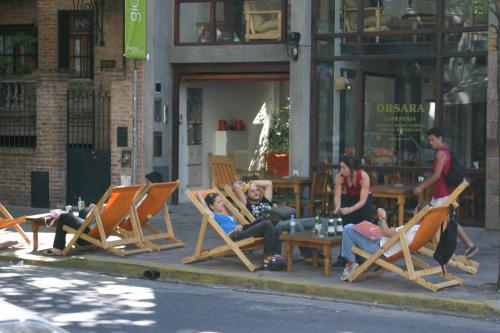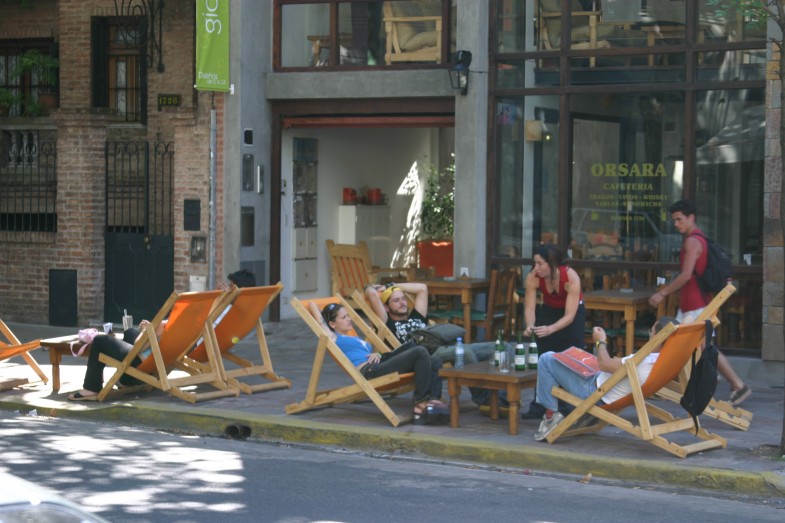One of the worst things ever to hit our communities was the belief that homes, shops and workplaces should be strictly segregated from one another. Devised around the turn of the 20th century, when it did make sense to locate iron foundries and tanneries away from schools and apartment buildings, this idea of “single use zoning” took off to a ridiculous degree after World War II when corner stores, offices and even diners were deemed a threat to nearby homes.

Enjoying the pleasures of a mixed-use neighborhood in Buenos Aires. Photo by Ethan Kent/Project for Public Spaces
These zoning codes also represent a direct assault on long traditions of the commons. From the town pump and market squares of the Old World to Main Streets and corner business districts in North American. cities, communities are enlivened by local gathering spots where people can meet one another while shopping or running errands. Such places provide the common ground out which the life of community grows.
The legacy of these misguided zoning laws is that today many communities are alarmingly dull— with no place to go, nothing to do, and no one to see. But more and more people are coming to appreciate the advantages of being able to shop and work the same place they live—especially now that most workplaces and stores are far more benign than at the height of the industrial age.
As anxiety mounts about worsening congestion, proliferating sprawl, rising gas prices, global warming and our expanding waistlines, it only makes sense to arrange our lives so we can meet many of our daily needs without climbing into a car. That was the natural pattern of human settlement throughout history until about 1950.
All great neighborhoods the world over function as villages, which means a place where many of our basic needs—a grocery, a school, a café, a hardware store, a park, a childcare center, a transit stop and perhaps an ice cream shop, library or video store—are within a short stroll of home. Look around your own town, and you’ll find that neighborhoods with these qualities are usually the most desirable places to live.
One trend helping improve our cities is that local shopping districts are springing back to life. What were once soda fountains and haberdasheries, and later vacant storefronts or makeshift apartments, are now restaurants and shops once again. Entrepreneurs, many of them recent immigrants or young people, are leading this charge to revitalize commercial streets in inner cities and inner suburbs coast-to-coast. But these entrepreneurs depend on the help of local citizens, as customers and as advocates. Often it’s necessary for the neighbors to turn up at zoning hearings or for neighborhood leaders to lobby the city council to overturn regulations that stand in the way of community revitalization.
There are many archaic laws that prohibit the kitchen expansion necessary to turn an old delicatessen into a new bakery, or that demand a bookstore provide a parking lot even though the vast majority of its customers walk there. These kind of out-of-date laws can be a huge deterrent to the revitalization of urban neighborhoods, and it’s important for neighbors to pull together to fight them.
A prime place to see this trend in action is Brooklyn, which once took a definite back seat to the dazzling excitement of Manhattan. But no more. Stroll down the commercial streets of the borough today and you’ll encounter a cornucopia of ethnic restaurants, bistros and boutiques alongside the locally-owned groceries and taverns that have always been these neighborhoods’ lifeblood.
The same goes here in Minneapolis where I live. Coffee shops, vintage clothing stores and funky gift shops have popped up in corner business districts across town. At first these business owners had to work hard to get variances from zoning laws to open up for business—and I logged quite a few hours at planning meetings speaking out in favor of their existence. There was an old guard around town that thought the best, safest neighborhoods were strictly residential with no shops in sight and no people populating the sidewalks. But those days are long gone. Nowadays people in Minneapolis couldn’t imagine life in without their local coffee shop down the street.
This is adapted from the Great Neighborhood Book](New Society Publishers).



